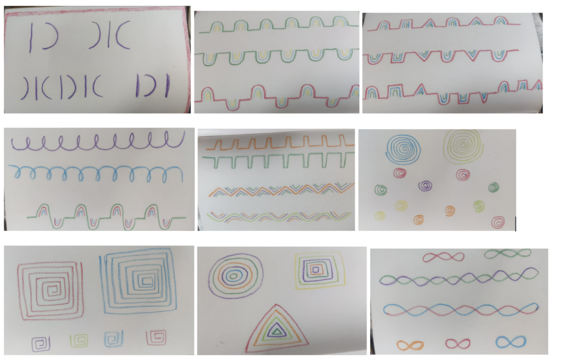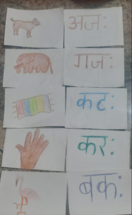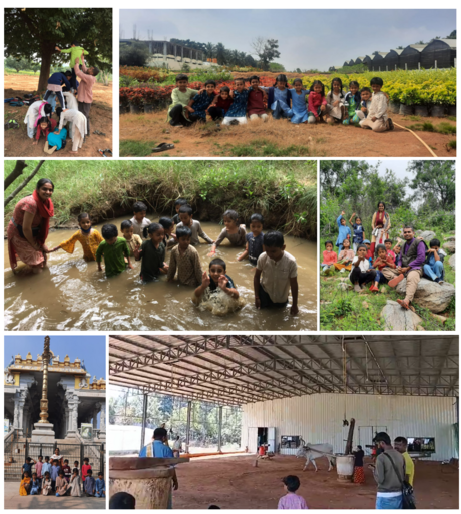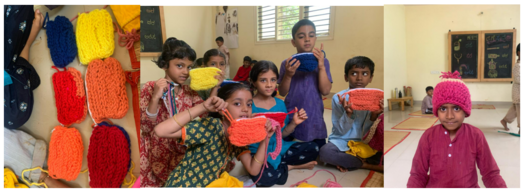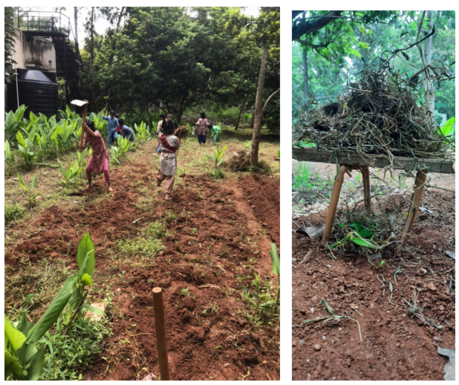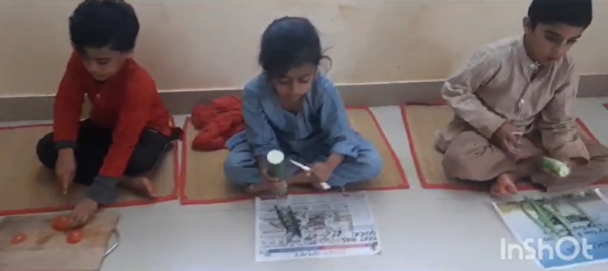Difference between revisions of "Class 1 Curriculum at Vidyakshetra"
(Added Images) |
(Added Images) |
(No difference)
| |
Latest revision as of 15:46, 24 May 2024
Introduction to Baal-avastha (6yrs to 12yrs)
Class 1 starts at the age of 6 years and forms a part of the age group called Baal-Avastha (बाल अवस्था) which ranges from 6 years to 12 years.
The first 6 years of the child is likened to the potter preparing the clay. The next 6 years is when he will use that prepared clay by patting it vigorously, moulding it, giving it a perfect shape he desires and by putting it in fire. Likewise, the first 6 years of the child is the preparation for the next 6 years by providing it lot of love, security, fulfilling its every desire etc. The next 6 years focuses on character building, disciplining, and developing the personality of the child as this is the need of the child. If this phase of the child is handled tactfully, purposefully, keeping the goal in mind, without losing one’s self-control and patience, then the objective of giving shape to the child is fulfilled.
In this phase, the child’s school education begins. There are now two centers of learning for the child- one is at home and the other is the vidyalaya. The teachers are the foster parents of the child.
During this phase, the jnanendriyas (ज्ञानेन्द्रियाँ) and karmendriyas (कर्मेन्द्रियाँ) of the child are activated. Thus, they need to be nourished and developed.
For the karmendriyas (कर्मेन्द्रियाँ), hands, legs and speech have to become skillful. For speech development, we introduce languages such as samskrita and local language kannada. To nurture the gross and fine motor skills of the hand, writing is introduced as well as krishi etc Kreeda is a daily affair that ensures the all round physical development of the child and its overall healthy constitution.
To develop the jnanendriyas (ज्ञानेन्द्रियाँ), the child must have beautiful experiences of roopa (रूप), rasa (रस), Gandha (गंध), Sparsha (स्पर्श) and sravana (श्रवण). Therefore, in the later years, sangeeth too is introduced to mould the child’s aspects of beauty, flow, control and feelings. Activities such as painting, drawing helps them gain colour experience. Experience of the colour is more important than information of colour such as name of colour etc. Similar beautiful experiences must become a part of the curriculum in terms of beautiful sights, natural materials, pure foods etc. Such rich experiences build the overall positive outlook of the world for the child.
Thus, the learning for a child in the baal avastha has to be activity based so as to develop and sharpen the child’s karmendriyas, jananedriyas, mind and intelligence. Attention has to be paid so the child follows a good rhythm of the day. Good rhythms promote good habits - both bodily as well as mental habits for the child. These become their lifelong companions. Mental habits such as motivation to do work, faith and trust are natural to a child. They must be preserved and fostered so the goodness of the child emerges in form of its behaviour and attitude.
To build the mental capacity, rote learning is given a lot of importance. Brain capacities are expanded in this way so that that capacity can be used later. Memorization of shlokas, math tables etc. helps build these capacities.
Child is encouraged towards light tasks such as shramadaan (श्रमदान), washing and cleaning its own utensils, little bit of Krishi and watering plants etc. so that it develops a taste for work later in life.
The curriculum, pedagogy thus, is carefully crafted in developing the child’s capacities, moulding its character and giving shape to its intellect, feelings and ability to do work.
Classroom Rhythms
Children typically move from Shishuvatika to class 1 (refered to as Arambha in Vidyakshetra) when they turn 6. Readiness of the child is assessed for getting into formal education with respect to its physical development, its gross & fine motor function, ability to follow multiple step instruction, observing child’s social & creative skills at play etc. The sign that the development of internal organs is completed, and organs are stabilized is falling of the milk teeth and growth of arms to cover the head up to the ears on the opposite side. There is also an external assessment done for identified children for any special needs which Vidyakshetra is not able to take care of at present. If the assessment result suggests that child needs specialists to learn and grow properly and if teachers at Vidyakshetra are not equipped to handle it, then parents are guided with appropriate advice.
This is a year of transition from early childhood (शिशुअवस्था) to childhood (बालावस्था). The child is guided to start doing its age-appropriate work independently. During this transition, the child learns to listen and follow instructions or follow advice. The mindset needs to transition from playfulness to responsibility and to discipline. This is also the time when formal education begins. As this happens, educators focus on its character building, capability building and providing rich experiences of life continues.
Arambha children are at Vidyakshetra from 8:30am to 2:30pm. Following is how the typical timetable of the class looks like:
| Time | Activity |
| 8:30 am | Children arrival |
| 8:40am to 9:10am | Panchanga + Bhagavad Gita + Subhashita (at the school assembly) |
| 9:30am to 9:45am | prarambha, mandala samaya |
| 9:45am to 10:10am | Phalahara |
| 10:10am to 10:50 am | Shaikshanika (Academic Period) |
| 10:55am to 12:15am | Chatuvatike – Activity Time (activities such as Krishi / Knitting / Sanskrit Sambhashanam) |
| 12:15am to 1:35pm | OOTA (Lunch) |
| 1:35pm to 2:15pm | Winding Down (Kreeda / Painting) |
| 2:30pm | Leave for the day |
Start of the day (8:30am to 9:10am)
The day starts at 8:30am in the morning. Though Vidyakshetra starts at 7:15am for older classes, Arambha students start their day a little later. The first activity of the day is the assembly in Kalamantapa hall. They recite Panchanga, Bhagavad Gita and Subhashitas along with the other class students.
| अद्य्तन पंचांगम,
कल्युगाब्दः द्वाविंशतिः अधिक एक शातोत्तरः पंच सहस्त्रं शालिवानशकः त्रिचत्वारिम्शत अधिक नव शातोत्तर एक सहत्रम प्लव नाम संवत्सरः, दक्षिनायानाम, हेमन्त ऋतुः, मार्गशीर्षः मासः, कृष्ण पक्षः एकादशी तिथिः, गुरुवासरः, विशाखा नक्षत्रं, शुभः योगः, शुभः करणं, इदं दिनं, सर्वेषाम कृते, शुभम् भवतु
वाराद आयुष्य वर्धनम्, नक्षत्राद हरते पापम्, योगाद रोग निवारणं, करणाद कार्य शिद्धिश्च, पंचांग फलम् उत्तमम्, एतेषां श्रुनियो नित्यम्, गंगा स्नानम् फलम् लभेत
|
adytana paṁcāṁgama,
kalyugābdaḥ dvāviṁśatiḥ adhika eka śātottaraḥ paṁca sahastraṁ śālivānaśakaḥ tricatvārimśata adhika nava śātottara eka sahatrama plava nāma saṁvatsaraḥ, dakṣināyānāma, hemanta r̥tuḥ, mārgaśīrṣaḥ māsaḥ, kr̥ṣṇa pakṣaḥ ekādaśī tithiḥ, guruvāsaraḥ, viśākhā nakṣatraṁ, śubhaḥ yogaḥ, śubhaḥ karaṇaṁ, idaṁ dinaṁ, sarveṣāma kr̥te, śubham bhavatu
vārāda āyuṣya vardhanam, nakṣatrāda harate pāpam, yogāda roga nivāraṇaṁ, karaṇāda kārya śiddhiśca, paṁcāṁga phalam uttamam, eteṣāṁ śruniyo nityam, gaṁgā snānam phalam labheta
|
Child is also exposed to Sanskrit shlokas, Subhashitas and Bhagavat Gita recitation apart from daily Panchanga. Children memorize one of chapter of Bhagavad Gita and a few subshitas etc. They typically start with smaller chapters such as chapter 15 or chapter 16. They practice this in class as well.
After this, children walk to the class. The class is a little far from Kalamandapa. To create a rhythm while walking back, children usually sing a song (to depict ants walking on a straight line in search of sugar) or shlokas while walking.
They reach the class by 9:30 am.
Class entry rhythm, mandala samaya (9:30am to 9:45am)
It is important to create a rhythm with children in everything they do. The first rhythm is for keeping their things in order. This includes lining the slippers outside the class, do Saraswati namaskar as they enter the class, keep their bags on the shelf and their water bottles on the table.
This is followed by mandala samaya. Rhythmic Movement woven into song, dance and activities forms the mandala samaya. It is an activity wherein iccha, kriya and jnana Shakti of the child finds nourishment. Child’s developing Annamayya kosha too gets exercised in the most harmonious manner. It also helps the child in settling down into the classroom rhythm for more learning throughout the day. This mandala samaya would be encouraged for all the subsequent years, though the type of activity and the complexity would differ with each passing year. For Arambha, this is the first class-activity of the day inside the classroom. There is a different thing which happens every day of the week and then these activities get repeated for the subsequent weeks. This is an important activity to transition the students into the classroom environment. Following are the set of activities which are included in mandala samaya:
- Seasonal and festival related with action and movement for songs and Rhymes in Kannada and Sanskrit
- Activity with bean bag: This is a very unique and powerful way of bringing in focus, enabling child’s cross lateral functioning, gross motor skill development at the same time. The complexity level increases every year. In the first year, children do bean bag movement by passing the bean bag to their neighbour. They learn to listen, think and act at the same time.
- Few Surya Namaskaaras
- Skipping: Multiple ways of skipping – single and multiple. This is a very powerful activity to strengthen legs-eye coordination and the ability to anticipate.
- Songs and games related to math tables and skip counting revision.
Phalahara (9:45am to 9:55am)
Children wash their hands and have their breakfast outside the class. Children bring their fruit boxes from home. The teacher ensure that children are sitting in a mandala on the floor and then having their fruits. Children are observed to eat slowly, chew well, finish what they brought, wash their boxes and keep them back. The rhythm of doing all this by themselves, day after day, week after week is the key aspect. It helps build their sense of responsibility, task completion, as well as drives away laziness.
As the mandala samaya and phalahara is going on, children from senior classes would come into the classroom for Shram Daan. This includes brooming, mopping and cleaning the class room to make it ready for taking the class. One principle of sharm daan at Vidyakshetra is that none of the class children clean their own class room.
Shaikshanika (10:10am to 10:50am)
This is the time duration for academic subjects. There are four main themes of academic subjects, which children learn, as a part of Shaikshanika:
- Roopchitra (रूपचित्र)
- Math (गणितम्)
- Languages – Sanskrit and Kannada
- Nature Walk (प्रकृति परिचय)
Roopchitra (रूपचित्र)
Roopchitra is all about imagining and creating forms. There are no picture books, only imagination. The forms are given in story form and then walked by the children in the following day. There are two characters which form a part of many stories – Putta (पुट्टा) and Putti (पुट्टी). This is a common feature of all the primary classes where such favourite characters are chosen specific to classes. With stories of Putta and Putti, certain patterns are formed on the ground and children follow those patterns.
Typical forms which get covered in Arambha are – Straight lines / Curved Lines / Simple Running Forms / Squares / Spirals / Simple horizontal mirror images.
Once they can imagine the forms with movements, they start making those patterns on sand with fingers. This is followed by drawing on slate, then in practice books and then in academic books. For all the writing in books, children use Jumbo crayons. It offers better control and change direction without changing thickness. In Shishuvatika, they were introduced to block crayons. Now they are used for making borders in the academic books.
Children are taught to make the form in one sweeping movement. As much as possible, the crayon should stay on the page from start to finish. They cannot stop and lift the crayon in between. There is a sequences identified as lesson plans, in which the children start learning to get control on their fingers and imagination. Teachers also learn to identify the temperament and nature (प्रकृति) of the child by observing their form drawings. This identification can help the teachers manage the child better. Also, for certain temperaments, specific types of forms can be very healing. Below is an example of some of the form drawing done in Arambha.
Roopchitra as a subject is very powerful and supports many learning capabilities: improved hand to eye co-ordination, spatial orientation, observation skills, focusing attention, confident movement, drawing skills and the foundation skills for handwriting.
Math (गणितम्)
In the past years, we start leaning Math in Kannada language. From 2023, we have started teaching Math in Sanskrit language. Following is achieved in the class:
- Shloka – The class starts with learning and by-hearting 3 shlokas:
यथा शिखा मयूराणां, नागानां मणयो यथा । तद् वेदांगशास्त्राणां, गणितं मूर्ध्नि वर्तते ॥ लीलागललुल लोलकालव्याल विलासिने । गणेशाय नमो नीलकमलामलकान्तये ॥ एकं च दश च शतं च सहस्रं तु अयुतनियुते तथा प्रयुतम् । कोट्यर्बुदं च वृन्दं स्थानात्स्थानं दशगुणं स्यात् ॥
- Identifying Numbers – Brahmgupta method of identifying numbers is used. This includes showing pictures and their counts. Like ‘Surya’ is One, ‘Trishool’ is three. Games are played including mental math, count and match etc.
- Counting Numbers – 1 to 100. Oral and written. Writing is done in Devanagari script. Numbers are written and read from right to left, as is the case with Sanskrit. For example, in number 45, first 5 is mentioned and then 40 is mentioned. In Sanskrit, it would be panchachatvarinshat (पञ्चचत्वारिंशत्).
- Tables – Tables and skip counting in Sanskrit from 1 to 5 and 10. Tables are learnt in the form of songs and skip counting is learnt as rhythm of claps.
- Introduction to the four operations – Operations of addition, subtraction, multiplication and division are introduced not as operations but as stories. The characters of the stories are from Ramayana, Mahabharata or Puranas.
Languages – Sanskrit and Kannada
Children learn two languages – Kannada and Sanskrit. For both the languages, the process of learning follows the sequence of spoken language (संभाषणं) and then Lipi writing. Writing also starts with words and moves on to letters. Example of words with flashcards is shown in the image.
As is the pedagogical principal at Vidyakshetra, there are no textbooks for children. All the delivery happens using songs, stories, drama and board drawings. Board drawings are a big part of this methodology so as to trigger and nourish the imagination of the child. When a child is able to imagine vividly, his creative side is awakened. Teachers are specifically trained to deliver stories via board drawings. Here are some sample board drawings used by the teacher.
Nature Walk (प्रकृति परिचय)
This started with Shishuvatika and continues in Arambha. Children go out to be with nature and observe different things. Once in a month they are taken out to nearly lake, nursery, nearby small hill, temple, Ramakrishna Ashram or park. Remaining days they do their observations within the premise with things like pottery, tree climbing, bird watching, leaves or feather collection, making decorative items out of it etc. Once children are back to the class, everyone expresses their observations, feelings and thoughts. This is an important subject to establish their connection with nature.
Chatuvatike – Activity Time (10:55am to 12:15am)
After Shaikshanika, the rhythm shifts to activity of the hands. This includes Krishi or Knitting or Fireless cooking. One of the two is typically done. Sometimes, Sanskrit Sambhashanam is also practiced during this time.
- Knitting: Finger Knitting is very important for children to establish good amount of control on their hands and fingers. Children learn 2-finger knitting, 4-finger knitting and needle knitting.
- Krishi - Krishi is very important subject to create the emotional connect between children and nature as well to ignite and inspire its interests in doing work. Children learn and observe how nature functions and nourishes. Children do activities including watering, sowing, cleaning weeds, composting, collecting leaves for composting, making patty etc.
- Fireless Cooking (bring ingredients from home) - Includes cutting, pounding, grating, peeling etc which help strengthen the hands- develops its gross and fine motor skills as well hand-eye coordination. It helps children connect with food in a very personal manner. Whatever is cooked by them becomes a very precious intake for them. Whatever is cooked, is shared by all the children during lunch time.
Lunch Time (12:15pm to 1:35pm)
Lunch is prepared at Vidyakshetra every day. The menu is not decided by the children.
The body (अन्नमय कोष) of the child is developing. Therefore, his nourishment is well taken care of. A balanced menu as per ayurvedic principles has been developed, organic rice, dals and vegetables procured and a roster of parents along with a cook prepare lunch on a daily basis. Such food is offered with love and care to children in Arambha.
Though, there is a lunch space in Vidyakshetra, Arambha children eat lunch in their own class. Lunch time gets divided into three parts:
- Pre-Lunch Shram Daan: Along with the teacher, children clean the classroom and make it ready for lunch. They wash plates, arrange tubs with water and arrange soaps. It is very important to cultivate these good habits at this stage of life. Such activities helps the child develop interest in doing work and helps them develop an eye for cleanliness and habit of doing one’s own work which is a very important life-skill.
- Lunch: Children sit in a mandala and then the teachers serve lunch to the children. They are trained to eat what they are served. Children wash their hands, sit in a mandala and the teachers serve the children. Every child must take a sufficient portion of lunch. They are encouraged to finish the lunch in the stipulated time, chewing well and finishing all what they have taken. Before starting the lunch, they recite the Bhojan mantra (भोजन मंत्र) along with the teacher:
ॐ सहनाववतु, सह नौ भुनक्तु, सह वीर्यं करवाव है ।
तेजस्वि नावधीतमस्तु मा विद्विषाव है ।।
ॐ शान्तिः शान्तिः शान्तिः ।।
oṁ sahanāvavatu, saha nau bhunaktu, saha vīryaṁ karavāva hai ।
tejasvi nāvadhītamastu mā vidviṣāva hai ।।
oṁ śāntiḥ śāntiḥ śāntiḥ ।।
- Post-Lunch Shram Daan: After finishing, children, along with teachers, clean up the whole place along with the teacher. They clean the classroom, wash the plates, and mop the entire place. Teachers predominantly clean up and children are engaged in the process.
Winding Down (1:35pm to 2:15pm)
It has been a hectic day for the children. They need to wind down before heading home. Two activities which they take up are Games (क्रीडा) or Painting.
Kreeda: Children play a lot of desi games including games like tiger and calf, tree house games etc. The physical development of children at this age is through play. They love to play and therefore ample opportunity is provided for them to play indoor as well as outdoor games.
Painting: This is a very important subject for development of feelings, expressions etc. Colour experience, as already mentioned earlier forms an integral part of nurturing the intellect and giving the child a very rich experience, a very happy and satisfying experience very early in life. Painting is typically done wet-on-wet. Children paint only with single colours with warm and cold version of Red, Yellow and Blue. They learn to make different strokes – horizontal, diagonal and vertical. This is a very silent space to allow the children to immerse themselves and express themselves. The class starts with teacher doing the setup of the class. Teachers shows how to paint with children sitting all around her. Teacher also tells a story while painting. Then the students paint silently on their own. Different strokes by different children are recalled the next day. They try and figure out if they can see some familiar figure emerge due to their strokes.
Post 2:15pm, children start preparing to leave for the day. By 2:30pm, they leave either by bus or with their parents.
Parent Engagement
All this is aided by deep engagement with parents to educate them as well for the right environment at home. This happens at three levels:
- Arivu (3 times a year)
- Study Circles and Manthan (weekly and monthly rhythms)
- Sameeksha (twice a year)
Arivu
Arivu is a class level discussion. This means that individual children are not the topic of discussion, but class in general is. This happens 3 times a year at one of the parent’s houses on rotation basis. One parent hosts the other parents for a simple dinner. All the parents get an informal environment to interact with each other and the teacher gives a glimpse of the dynamics of Arambha. Parents get to know the curriculum which was covered till now and the curriculum which would be covered in the time to come. Behavioral patterns, ways to handle them, support needed from parents, environment changes at home etc. are typical discussion items.
Study Circles and Manthan
All the parents engage in study circle with weekly rhythms of meeting. The content of study circle includes a set of books, videos, visits, expert meetings, writings and presentations. The study circle is lead by the acharya of Arambha, supported by some senior acharyas in Vidyakshetra. The topics range from holistic development, Panchkoshas, Kutumb, samaj, Rashtra, varnashrama, seva, Purushartha, Ramayana, Mahabharata etc. The discussion also involves issues, problems, techniques and tools for baal avastha (बालावस्था). The study circle meets in a weekly rhythm on Saturday. In a month, 3 Saturdays are online meetings and 4th Saturday is an in-person meeting. In-person meetings help do manthan (“मंथन”) of ones understanding of various aspects of life and education for life. The goal of this setup is to bring in the alignment between the understanding of the parents and teachers, so that there is consistency in what the child gets both at home and at gurukul. It is a deep engagement with parents to educate them as well for the right environment at home.
Sameeksha
This is an assessment of a child’s progress and happens as a 1-1 discussion between the parents and the teacher. Panchkosha development, habits, behavior, character etc. gets discussed. If there are learning difficulties for the child or inconsistencies in behavior, they are discussed and possible plan to address those is arrived upon. This Sameeksha happens twice a year.
Conclusion
The change from early childhood (शिशुअवस्था) to childhood (बालावस्था) is gradual. The first two years of childhood are these transition years. Of these, the first year is in Arambha. In these transition years, the child starts doing its own work itself. During this transition, the child learns to listen and follow instructions and advice. The mindset needs to transition from playfulness to responsibility and to discipline. This is also the time when formal education begins. The teachers and parents need to handle this transition well.
